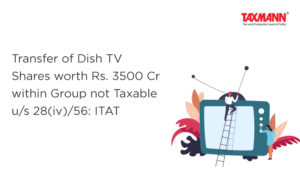Transfer of Dish TV Shares worth Rs. 3500 Cr within Group not Taxable u/s 28(iv)/56: ITAT
- Blog|News|Income Tax|
- 2 Min Read
- By Taxmann
- |
- Last Updated on 3 March, 2023
Case Details: ACIT vs. Direct Media Distribution Ventures Pvt. Ltd. - [2023] 148 taxmann.com 35 (Mumbai-Trib.)
Judiciary and Counsel Details
-
- Amit Shukla, Judicial Member & S. Rifaur Rahman, Accountant Member
- Jay Bhansali for the Appellant.
- Madhur Agrawal & Manoj Kumar Sinha for the Respondent.
Facts of the Case
Assessee, a company, was a subsidiary of ESSEL group of companies. During the relevant assessment year (AY 2012-13), the entire shareholding of assessee was acquired by the holding company, making it a wholly owned subsidiary. As part of the internal restructuring, it was mutually agreed that equity shares of Dish TV India, a listed company, will be transferred to the assessee as a gift without consideration.
During the assessment proceedings, the Assessing Officer (AO) determined that the receipt of shares is a colourable device and taxed the fair market value of such shares in the hands of assessee by invoking section 56.
Aggrieved-assessee preferred an appeal to CIT(A). The CIT(A) deleted the additions made by AO and the matter then reached the Mumbai Tribunal.
ITAT Held
The Tribunal held that a receipt can only be taxed under the express provisions of the Act and not every receipt can be subject to tax. It is not a matter of dispute that the receipt of shares is a capital receipt in the hands of assessee and classified as an investment. The nature of the receipt remains the same even if transferred at nil consideration. A capital receipt can be taxed only if specific provisions to tax the receipt are in place. Therefore the receipt is not liable to tax as per section 56(1)
Further, the deeming provision of section 56(2)(viia) is applicable only in case where shares of a private limited company are received. Shares of Dish TV, a listed company and not a private limited company, will not attract the provisions of section 56(2)(viia).
In the instant case, the provisions of section 56(2)(x) are also not applicable as the same were introduced (w.e.f. 01.04.2018) after the relevant assessment year (AY 2012-13).
In addition, the shares were not transferred due to the business dealings, the receipt cannot be taxed under section 28(iv) as the receipts are not arising out of activities carried out for business or profession.
Disclaimer: The content/information published on the website is only for general information of the user and shall not be construed as legal advice. While the Taxmann has exercised reasonable efforts to ensure the veracity of information/content published, Taxmann shall be under no liability in any manner whatsoever for incorrect information, if any.

Taxmann Publications has a dedicated in-house Research & Editorial Team. This team consists of a team of Chartered Accountants, Company Secretaries, and Lawyers. This team works under the guidance and supervision of editor-in-chief Mr Rakesh Bhargava.
The Research and Editorial Team is responsible for developing reliable and accurate content for the readers. The team follows the six-sigma approach to achieve the benchmark of zero error in its publications and research platforms. The team ensures that the following publication guidelines are thoroughly followed while developing the content:
- The statutory material is obtained only from the authorized and reliable sources
- All the latest developments in the judicial and legislative fields are covered
- Prepare the analytical write-ups on current, controversial, and important issues to help the readers to understand the concept and its implications
- Every content published by Taxmann is complete, accurate and lucid
- All evidence-based statements are supported with proper reference to Section, Circular No., Notification No. or citations
- The golden rules of grammar, style and consistency are thoroughly followed
- Font and size that’s easy to read and remain consistent across all imprint and digital publications are applied








 CA | CS | CMA
CA | CS | CMA


